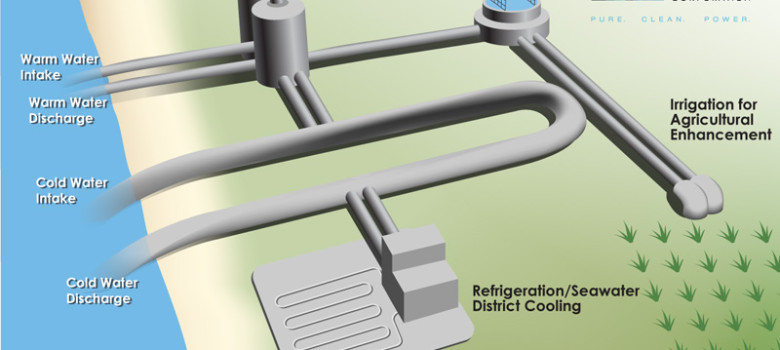
What is OTEC?
OTEC stands for Ocean Energy Thermal Conversion. It is all about using the differences in warm and cold temperatures of oceans to produce useful products like electric power for coastal or island communities. With increases in energy prices and technical innovations over the last few years, OTEC systems, such the one produced by the Ocean Thermal Energy Corporation, are becoming viable technological solutions to help provide some of the world’s energy requirements.
OTEC technology cannot currently be used across the globe because the heat gradient needed for the OTEC operation needs to be of a sufficient level. Therefore it tends to be concentrated among the hottest parts of the planet which are between the tropics. Therefore, it may not be suitable as an electricity energy solution for some European and Northern countries. UK companies and people interested in this technology do read on, because although the processes may not be suitable for direct electricity generation, indirectly, companies such as BG Group, BP and Shell can exploit existing offshore infrastructure, which includes existing oil and gas rigs located in the warm parts of the world, upgrade for OTEC technology, and supply hydrogen, the next generation fuel, for cars and household boilers to be used all round the world.
OTEC is not like wind power or solar power (which are intermittent), because the technology can operate on a 24-7 basis. Oceans act as incredibly large solar energy collectors, absorbing about 80% of the sun’s energy. This means that every day, the oceans on our planet absorb solar energy equivalent to 250 billion barrels of oil, and if we could convert 0.1% of this energy into electricity each day, it would supply a significant proportion of electricity and fresh water requirements for agriculture for tropical, coastal regions of the world.
How does OTEC work?
OTEC Warm and Cold Water
OTEC (Ocean Thermal Energy Conversion) works by using the temperature gradients found in large bodies of water, where the temperature of water found on the surface is significantly higher than the cold water found deeper down. The largest water temperature gradients exist in tropical oceanic regions, because not only do you have the very warm water, but you also have oceanic depth to make use of cold water currents. For example, just off the coast of Puerto Rico, you have an oceanic depth of about 3000 metres, and therefore the temperature of the surface and deep water can vary by more than 20 °C, which is absolutely perfect to exploit the OTEC process.
OTEC Process
An OTEC power plant works by pulling in warm ocean surface water and this is used to heat a ‘working fluid’ such as ammonia or propane into a gas. These fluids have a low boiling temperature, which when turned into gas, moves the steam into pressurised shafts that are then used to drive turbines. The turbines then drive the generator, which converts mechanical energy into electrical energy. You may now know this part from the heat Rankin Cycle, which underpins electricity generation for current processes such as biomass, nuclear and fossil fuels. A long pipe accessing the very cold water from the depth of the ocean is used to cool and liquefy the gas back into working fluid, so the process can start again.
As the ocean water can only heat the working fluid by about 20oc, the steam produced from the OTEC process unfortunately doesn’t carry much energy. However, as the resource, which is ocean water, is abundant, an OTEC power station can harness much of the energy it produces by counting on the large volumes of hot and cold water it requires to operate which goes some way to counteract the lack of efficiency problem.
OTEC technology can be harnessed to produce Seawater District Cooling (SDC). This is when pipework takes in deep water, which is cold. It then harnesses this cold water for district air-conditioning as opposed to using lots of electricity and chemicals seen in current systems. These types of systems can save up to 80% or more on electricity usage.
Seawater/air conversion
The extensive difference in temperatures found between seawater and air in coastal arctic regions can be exploited using a similar technique to OTEC. Where ammonia or propane is used in OTEC systems, liquid butane has to be used in arctic locations due to its lower boiling point. The relative heat of the seawater is used to transform butane into a gas that drives turbines, before the winter arctic air temperature, which can fall to -22 °C, rapidly condenses it and allows for the continuation of the cycle. Although this technique is in its infancy, the fact that it requires half the amount of seawater extraction pipes compared with the OTEC system makes it potentially less expensive and therefore a more efficient concept.
OTEC Industry Development
OTEC Company Innovation
OTEC technology was pioneered in the late 19th century, but it has only been recent technological advances in heat exchangers that have made the technology a viable commercial source of energy. Companies such as Lockhead Martin, Ocean Thermal Energy Corporation and Makai Ocean Engineering, who have become leaders in the development of this technology, are looking to bring it to market on a large commercial scale. They have managed to gain leverage from the expertise in Hawaii, for example, which has the right ocean temperature variations and depth required for this technology to work. Since the 1970s, the US established Natural Energy Laboratory of Hawaii, has become the leading test facility of the energy source due to the region’s warm water surface, and very deep, very cold water.
OTEC onshore vs. offshore facilities
OTEC technology is not all about electricity generation, it has a much wider scope than that. An onshore OTEC facility can for example not only create electricity, but other products that include fresh water and hydrogen that can promote agriculture and be used as a fuel, respectively. The upwelling of cold water from the depths of the ocean also helps aquaculture thrive, through its fertilising capabilities. Together with a SDC system it can provide the power requirements of an island or coastal community, create jobs and safeguard energy security at low cost which doesn’t cause damage to the environment.
An offshore OTEC facility, as previously mentioned, can be harnessed by companies and countries that are currently involved in deep sea mining exploitation in remote locations. For instance existing deep water, offshore platforms can be upgraded with OTEC technology for the production of hydrogen fuel. It seems evident that oil and gas companies that also have the transportation facilities can use existing machines to transport this fuel around the world.
The future for OTEC
We need to move away from the burning of fossil fuels and move to a technology like OTEC to not only produce the energy requirements, but to produce an alternative fuel like hydrogen, that can be combusted as an alternative. Fossil fuels are wasted in the combustion processes as this deprives future generations of key materials (e.g. plastics) required for commercial and domestic purposes. OTEC is not suitable for all locations, but tropical waters are abundant, so can be used in conjunction with other renewable energy sources to help drive a world free from fossil fuel dependence.












No Comments yet! Be the first one.